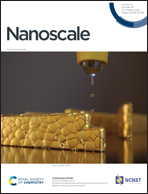Long-range electron transport in Prussian blue analog nanocrystals†
Abstract
We report electron transport measurements through nano-scale devices consisting of 1 to 3 Prussian blue analog (PBA) nanocrystals connected between two electrodes. We compare two types of cubic nanocrystals, CsCoIIIFeII (15 nm) and CsNiIICrIII (6 nm), deposited on highly oriented pyrolytic graphite and contacted by conducting-AFM. The measured currents show an exponential dependence with the length of the PBA nano-device (up to 45 nm), with low decay factors β, in the range 0.11–0.18 nm−1 and 0.25–0.34 nm−1 for the CsCoFe and the CsNiCr nanocrystals, respectively. From the theoretical analysis of the current–voltage curve for the nano-scale device made of a single nanoparticle, we deduce that the electron transport is mediated by the localized d bands at around 0.5 eV from the electrode Fermi energy in the two cases. By comparison with previously reported ab initio calculations, we tentatively identify the involved orbitals as the filled Fe(II)-t2g d band (HOMO) for CsCoFe and the half-filled Ni(II)-eg d band (SOMO) for CsNiCr. Conductance values measured for multi-nanoparticle nano-scale devices (2 and 3 nanocrystals between the electrodes) are consistent with a multi-step coherent tunneling in the off-resonance regime between adjacent PBAs, a simple model gives a strong coupling (around 0.1–0.25 eV) between the adjacent PBA nanocrystals, mediated by electrostatic interactions.



 Please wait while we load your content...
Please wait while we load your content...